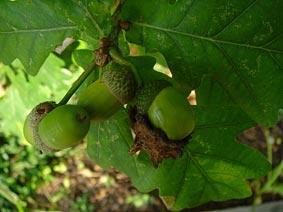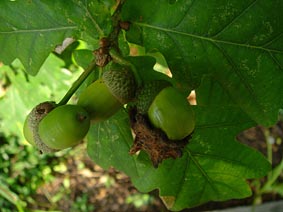Nature: Choking the oak

Our lovely autumnal oaks are being invaded by an ugly, sticky growth. There's only one course of action, says Éanna Ní Lamhna
Season of mists and mellow fruitfulness. Enjoyable autumn walks. Collecting conkers and acorns. Shock, horror! What is this awful growth that seems to be afflicting many of our acorns? Surely it is damaging them and making them unfit for reproduction? As can be seen from the photo below, this is a sticky enveloping growth on the acorn itself – green initially but quickly turning brown. If all our acorns get this, we'll have no oak trees left in a number of years. What is it and should we be worried?
We have two native species of oak in this country – the sessile oak and the pedunculate oak. Sessile means having no stalk and pedunculate means having a peduncle or stalk. In the case of oak trees, this means the sessile oak has acorns stuck to the twig with no stalk. This oak tree is also known as the Irish oak and grows on acidic soils in places like Killarney and Glenveagh. It is perfectly happy and has no nasty extuberances emanating from its acorns.
The pedunculate oak has its acorns out on stalks. It is known as the English oak and can grow on heavy lowland soils and put up with flooding. Such an oak occurs in places like Charleville in Offaly and in Abbeyleix. It is quite often planted as a parkland tree. This is the species that is shown here with its stalked, knobby acorns – one of which is sporting a knopper gall. This gall was caused by a wasp-type insect with the name Andriscus quercusalicis, which laid an egg in the forming acorn. The reaction of the egg with the growing acorn tissue caused it to change its growth form and produce this invading mass of cells, which are in fact food for the growing baby wasp.
This gall wasp has the most amazing life cycle. It has alternating sexual and asexual generations and it needs two oak species – the native pedunculate oak and the introduced evergreen Turkey oak – in order to complete its life cycle. The female wasp first lays her eggs on the roots of the Turkey oak in spring. These grow into sexual male and female wasps, which mate in a normal manner (for wasps that is). The mated female then goes and lays her eggs on the developing acorn and the ensuing growing larva causes the disfigurement that we see in autumn on the acorns – the knopper gall. The creatures that emerge from these are all female. They overwinter like this and in spring – without ever laying eyes (or anything else) on a male – go on to lay eggs on the roots of the Turkey oak.
So before Turkey oaks were ever introduced to this country we had no knopper galls. And while every acorn is not so afflicted, you know what to do if you are worried about the survival of your native pedunculate oaks. Get rid of the Turkey oaks in the vicinity and there will be no breeding habitat for those weird, asexual female gall wasps.
Simple really!
